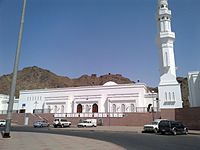Muhammad Hayyat ibn Ibrahim al-Sindhi
Muhammad Hayyat ibn Ibrahim Al-Sindi | |
|---|---|
| Personal | |
| Born | |
| Died | 3 February 1750 |
| Religion | Islam |
| Era | 18th century |
| Region | present day Kufa |
| Denomination | Sunni |
| Jurisprudence | Hanafi, Hanbali[1] |
| Movement | Sufism[2] |
| Tariqa | Naqshbandi[2] |
| Muslim leader | |
show
Influenced | |
| hidePart of a series on Islam Sufism |
|---|
 |
|
|
| hidePart of a series on:
Salafi movement |
|---|
 |
|
|
Muhammad Hayyat al-Sindhi (Sindhi: محمد حيات سنڌي) (died 3 February 1750) was an Islamic scholar who lived during the period of the Ottoman Empire. He belonged to the Naqshbandi order of Sufism.[3][4][5]
Education and scholarship[]
Al-Sindhi was born in modern day Pakistan traveled locally to get his basic education.[6] Then he migrated to Madinah and studied closely with Ibrahim al-Kurani and his son Muhammaad Tahir al-Kurani.[7] Here, he was initiated into the Naqshbandi tariqa.[6]
Notable students[]
One of his students was Muhammad ibn Abd al-Wahhab, whom he met in 1136 Hijri. It was Abdullah ibn Ibrahim ibn Sayf who introduced him to Hayyat al-Sindhi.[6]
Views[]
Although trained in Hanafi law, he was also a scholar of the Hanbali school.[6]
References[]
- ^ Allen, Charles (2009-03-01). The Deobandi Cult and the Hidden Roots of Modern Taqleed in the name of Imam Abu Hanifa. Da Capo Press. ISBN 978-0786733002.
- ^ Jump up to: a b Allen, Charles (2009-03-01). The Deobandi Cult and the Hidden Roots of Modern Taqleed in the name of Imam Abu Hanifa. Da Capo Press. ISBN 978-0786733002.
- ^ John L. Esposito (edited by), The Oxford Dictionary of Islam, Oxford University Press (2004), p. 296
- ^ Islamic Law and Society. E.J. Brill. 2006-01-01. p. 216.
- ^ Haj, Samira (2008-10-02). Reconfiguring Islamic Tradition: Reform, Rationality, and Modernity. Stanford University Press. p. 214. ISBN 9780804769754.
- ^ Jump up to: a b c d Voll, John (1975). "Muḥammad Ḥayyā al-Sindī and Muḥammad ibn 'Abd al-Wahhab: An Analysis of an IntellectualGroup in Eighteenth-Century Madīna". Bulletin of the School of Oriental and African Studies, University of London. 38 (1): 32–39. doi:10.1017/S0041977X00047017. Retrieved 26 April 2015.
- ^ Robinson, Francis (2001). The 'Ulama of Farangi Mahall and Islamic Culture in South Asia (Illustrated ed.). C. Hurst & Co. Publishers. ISBN 1850654751. Retrieved 30 April 2015.
Categories:
- Sindhi people
- 18th-century Muslim scholars of Islam
- Sunni Muslim scholars
- Naqshbandi order
- Hadith scholars
- 18th-century scholars
- 1750 deaths
- Arab people of Sindhi descent
- Islamic scholar stubs